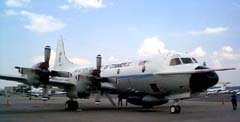|
NOAA EXPERIMENT AIMS TO IMPROVE WINTER STORM FORECASTS ALONG WEST COAST
The project is called PACJET, Pacific Landfalling Jets Experiment, and is a collaborative effort between NOAA, the U.S. Navy, other government and university entities. Its goal is to gain further insight into how the "low level jet," a fast moving current of air centered at 3,000 feet altitude, impacts weather patterns and, thereby, improve the accuracy of short (0-24 hour) range weather forecasts along the West Coast. The experiment will be based in Monterey, Calif., and will run from Jan. 20 to Mar. 4, 2001. Given the impact of these storms on the West Coast, accurate and timely forecasts and storm watches and warnings have become vitally important. While NOAA has an extensive network of Doppler weather radars, weather balloons, advanced satellites and surface observing systems across the United States, the Pacific Ocean, where many weather systems form, is data sparse by comparison. Dr. F. Martin Ralph, the project leader from NOAA's Environmental Technology Laboratory in Boulder, Colo., says forecasters are particularly interested in improving the prediction of coastal storms. "Hazardous weather due to these storms has caused major loss of life and property in the West Coast states of California, Oregon and Washington over the years," said Ralph. High winds, heavy rain and
extreme flooding can occur in a very short period of time as
these storms reach land. Ralph believes that by focusing the
latest technology and tools on this problem, it may help researchers
learn more about the causes of these storms and provide forecasters
with better information. "The local and state emergency management community felt strongly that the data delivered to forecasters by CALJET were extremely valuable in saving lives and property," Ralph said. PACJET will expand the geographic area covered by CALJET to include not only California, but Washington and Oregon, and will target the coastal zone, areas for which weather forecasts are more difficult to make because data about the incoming systems is often not available. NOAA's WP-3D "hurricane hunter" will be the flying laboratory in which much of the data is collected. Crewed by NOAA Corps officers and civilians from NOAA's Aircraft Operations Center in Tampa, Fla., the plane will fly out of Monterey, Calif., directly into the storms. An ozone sensor will be mounted on the plane to conduct air chemistry studies. Using a new satellite communications link, the P-3 aircraft will be able to communicate with forecasters on the ground on a real-time basis, enabling researchers to send forecasters radar images, audio transmissions, and other information from the aircraft. In addition, there will be ground-based instruments measuring wind and water vapor, and a new GOES satellite scan for cloud-tracked winds. National Weather Service Western Region Director Vickie Nadolski says this experiment will be invaluable to the forecasters. "Much of what forecasters deal with is dominated by events that happen in the short-term (0-24 hours) time scale, such as flooding or high wind events and issuing storm watches and warnings. This experiment will be a great help to us to better understand the influence of the low level jet and the ocean," said Nadolski. "And, we are also hopeful that as a result of this experiment, that long-term programs might be established that would infuse the most useful new technologies and techniques into our daily operations." Ralph says that the investment the country is making in weather and climate research and modernized weather services have and will continue to provide important benefits to the public. "Experiments like CALJET and PACJET will continue to expand our understanding of the interactions that occur between the ocean and the atmosphere," said Ralph. Relevant Web Sites |
